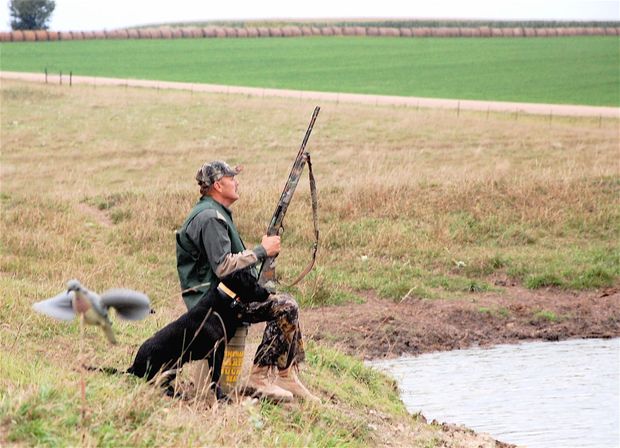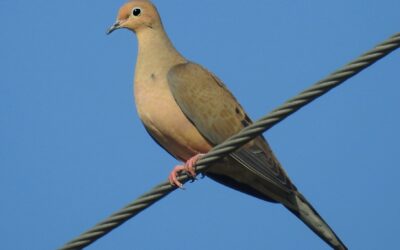Reprinted from the Sioux City Journal
SIOUX CITY | Dove hunting season will open Sept. 1 across the three-state area.
Hunters will take to the fields in the hopes of harvesting doves, which are nationally our most popular upland species.
I’ve hunted doves for many years in South Dakota and Nebraska. Iowa didn’t join the dove hunting states until 2011 when it became the 42nd state to do so.
There are a lot of things to like about dove hunting.
They are very numerous so lots of shooting can be expected. They are very challenging to hit. I’ve been told the national average is about three to five doves per box of shells. with a daily limit of 15, that means an excellent shot will burn three boxes of shells to attain that.
No other game bird offers that many shooting opportunities in a single day. That’s why dove hunting is such a good way to introduce a youngster to the sport. They will see lots of action.
And, finally, doves are very good eating.
Since doves, which can fly about 40 miles an hour, are such challenging targets, it pays to put as many odds on your side as possible before heading to the field.
First, the gun and loads. Any shotgun you are using now for pheasants or ducks will be fine for doves.
The regulations in all three states allow shotguns from 10 gauge on down. However, the gun must be plugged to fire no more than three rounds since the dove is a migratory game bird.
You will also need a hunting license and a PIN number. Refer to the regulations in your state to learn how to obtain the number.
From .410 to 12 gauge, from single shot to semi-auto, all will work just fine. I would, however, advise open chokes. Also, with the amount of shooting possible, one of the smaller gauges might be a good choice.
An improved cylinder choke is what I would recommend. For shot size, you can use anything from 7 1/2 up to 9 in one to one-and-an-eighth ounce. I’ve used them all but have come to rely on size eight.
Doves are not hard to drop, but they are very difficult to find, especially in thick cover. Keep your shots under 35 yards and if you drop one, mark it and walk to the mark immediately. If other doves are flying, ignore them until you retrieve your bird.
Dogs can help, but they are not as dependable as in finding other game. Doves don’t leave much odor.
Also, your dog may not like to retrieve doves. Many dogs don’t. So, you will have to help the dog as much as possible to find downed birds.
Since you get so much shooting, I like to use smaller gauges. Most of the time I’m shooting my over/under 28-gauge, but also use both my 20 and 16 double. I find them much more comfortable than shooting one of my 12s.
If I had to pick one gun for dove hunting, it would be a 20-gauge, semi-auto, choked improved cylinder shooting two-and-three-quarter-inch shotshells holding one ounce of number 8 shot.
Most of my hunting over the years has been at stock dams or dug outs during evening hours. Doves like to come in for a drink before going to roost each night.
It’s pretty consistent shooting from about 7 p.m., on, and the later it gets the better. Just before sunset they will often come in 10 or more at a time.
But there are other ways of hunting them.
Here is a day in the life of a mourning dove.
Doves leave their roosts early in the morning and fly out to a watering hole, take a drink, and then fly to the feeding fields. Doves are seed eaters so most crop fields will attract them.
After feeding, they will take some time off and return to the trees, usually about noon where they will perch. They may also visit watering holes or graveling sites before flying out to the fields again to feed.
They will revisit the watering holes in the evenings again before heading to the roost.
Walking shelter belts and flushing doves can be productive, as can walking in fields where they are feeding.
Large patches of hemp almost insures a number of doves feeding on the seeds.
The best approach is to get out there and scout before the season opens, find roosting areas, feeding fields, note flight patterns and watering areas.
When it comes to watering, doves like to land on a mud bank and walk down to the water. With all the rain we’ve had lately, finding a pond with a mud bank may be difficult.
You don’t have to be concealed as you do in duck hunting. We wear light camo and sit out in the open on plastic buckets painted black, brown or camo.
We usually use decoys, but I’m not convinced they really do any good. If anything works it might be the mojo decoys simply because of the wing movement.
Dove seasons are liberal in all three states running to Oct. 30 in Nebraska and South Dakota and through Nov. 9 in Iowa.
The first week of dove season will see the most birds on hand. A single cold snap, dropping temperatures 10 degrees or so at night, will send a bunch of them south. After a couple of weeks, numbers will probably drop off drastically and by Oct. 1 there could be very few of them around.
So for the best hunting and the largest number of birds, get out there early.
More outdoors information can be found at siouxcityjournal.com/sports/recreation/outdoors/





0 Comments